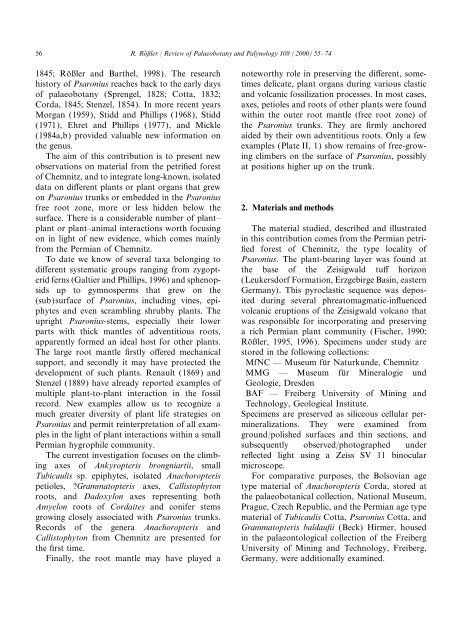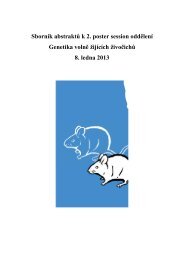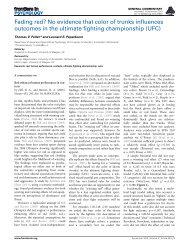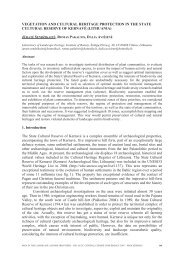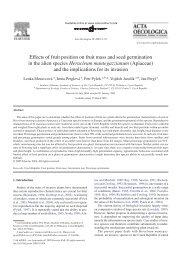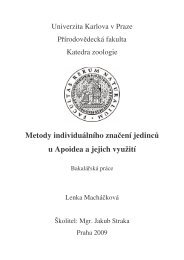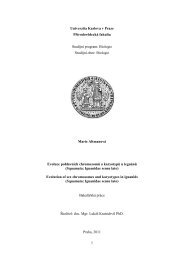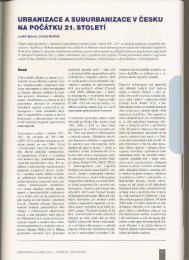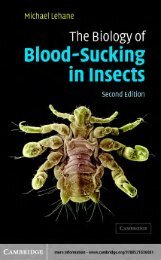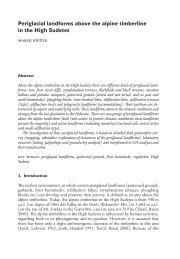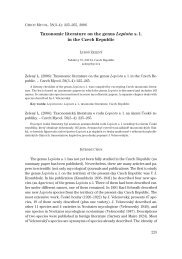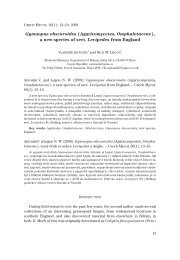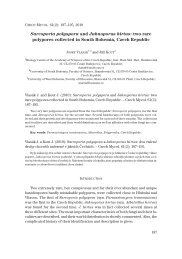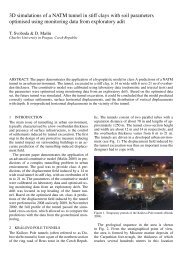The late Palaeozoic tree fern Psaronius — an ecosystem unto itself
The late Palaeozoic tree fern Psaronius — an ecosystem unto itself
The late Palaeozoic tree fern Psaronius — an ecosystem unto itself
You also want an ePaper? Increase the reach of your titles
YUMPU automatically turns print PDFs into web optimized ePapers that Google loves.
56 R. Rößler / Review of Palaeobot<strong>an</strong>y <strong>an</strong>d Palynology 108 (2000) 55–74<br />
1845; Rößler <strong>an</strong>d Barthel, 1998). <strong>The</strong> research noteworthy role in preserving the different, some-<br />
history of <strong>Psaronius</strong> reaches back to the early days times delicate, pl<strong>an</strong>t org<strong>an</strong>s during various clastic<br />
of palaeobot<strong>an</strong>y (Sprengel, 1828; Cotta, 1832; <strong>an</strong>d volc<strong>an</strong>ic fossilization processes. In most cases,<br />
Corda, 1845; Stenzel, 1854). In more recent years axes, petioles <strong>an</strong>d roots of other pl<strong>an</strong>ts were found<br />
Morg<strong>an</strong> (1959), Stidd <strong>an</strong>d Phillips (1968), Stidd within the outer root m<strong>an</strong>tle (free root zone) of<br />
(1971), Ehret <strong>an</strong>d Phillips (1977), <strong>an</strong>d Mickle the <strong>Psaronius</strong> trunks. <strong>The</strong>y are firmly <strong>an</strong>chored<br />
(1984a,b) provided valuable new information on aided by their own adventitious roots. Only a few<br />
the genus.<br />
examples (P<strong>late</strong> II, 1) show remains of free-grow-<br />
<strong>The</strong> aim of this contribution is to present new ing climbers on the surface of <strong>Psaronius</strong>, possibly<br />
observations on material from the petrified forest<br />
of Chemnitz, <strong>an</strong>d to integrate long-known, iso<strong>late</strong>d<br />
data on different pl<strong>an</strong>ts or pl<strong>an</strong>t org<strong>an</strong>s that grew<br />
on <strong>Psaronius</strong> trunks or embedded in the <strong>Psaronius</strong><br />
at positions higher up on the trunk.<br />
free root zone, more or less hidden below the<br />
surface. <strong>The</strong>re is a considerable number of pl<strong>an</strong>t–<br />
2. Materials <strong>an</strong>d methods<br />
pl<strong>an</strong>t or pl<strong>an</strong>t–<strong>an</strong>imal interactions worth focusing <strong>The</strong> material studied, described <strong>an</strong>d illustrated<br />
on in light of new evidence, which comes mainly in this contribution comes from the Permi<strong>an</strong> petri-<br />
from the Permi<strong>an</strong> of Chemnitz. fied forest of Chemnitz, the type locality of<br />
To date we know of several taxa belonging to <strong>Psaronius</strong>. <strong>The</strong> pl<strong>an</strong>t-bearing layer was found at<br />
different systematic groups r<strong>an</strong>ging from zygopt- the base of the Zeisigwald tuff horizon<br />
erid <strong>fern</strong>s (Galtier <strong>an</strong>d Phillips, 1996) <strong>an</strong>d sphenop- (Leukersdorf Formation, Erzgebirge Basin, eastern<br />
sids up to gymnosperms that grew on the Germ<strong>an</strong>y). This pyroclastic sequence was depos-<br />
(sub)surface of <strong>Psaronius</strong>, including vines, epiited during several phreatomagmatic-influenced<br />
phytes <strong>an</strong>d even scrambling shrubby pl<strong>an</strong>ts. <strong>The</strong> volc<strong>an</strong>ic eruptions of the Zeisigwald volc<strong>an</strong>o that<br />
upright <strong>Psaronius</strong>-stems, especially their lower was responsible for incorporating <strong>an</strong>d preserving<br />
parts with thick m<strong>an</strong>tles of adventitious roots, a rich Permi<strong>an</strong> pl<strong>an</strong>t community (Fischer, 1990;<br />
apparently formed <strong>an</strong> ideal host for other pl<strong>an</strong>ts. Rößler, 1995, 1996). Specimens under study are<br />
<strong>The</strong> large root m<strong>an</strong>tle firstly offered mech<strong>an</strong>ical stored in the following collections:<br />
support, <strong>an</strong>d secondly it may have protected the MfNC <strong>—</strong> Museum für Naturkunde, Chemnitz<br />
development of such pl<strong>an</strong>ts. Renault (1869) <strong>an</strong>d MMG <strong>—</strong> Museum für Mineralogie und<br />
Stenzel (1889) have already reported examples of Geologie, Dresden<br />
multiple pl<strong>an</strong>t-to-pl<strong>an</strong>t interaction in the fossil BAF <strong>—</strong> Freiberg University of Mining <strong>an</strong>d<br />
record. New examples allow us to recognize a Technology, Geological Institute.<br />
much greater diversity of pl<strong>an</strong>t life strategies on Specimens are preserved as siliceous cellular per-<br />
<strong>Psaronius</strong> <strong>an</strong>d permit reinterpretation of all exammineralizations. <strong>The</strong>y were examined from<br />
ples in the light of pl<strong>an</strong>t interactions within a small ground/polished surfaces <strong>an</strong>d thin sections, <strong>an</strong>d<br />
Permi<strong>an</strong> hygrophile community.<br />
subsequently observed/photographed under<br />
<strong>The</strong> current investigation focuses on the climb- reflected light using a Zeiss SV 11 binocular<br />
ing axes of Ankyropteris brongniartii, small microscope.<br />
Tubicaulis sp. epiphytes, iso<strong>late</strong>d Anachoropteris For comparative purposes, the Bolsovi<strong>an</strong> age<br />
petioles, ?Grammatopteris axes, Callistophyton type material of Anachoropteris Corda, stored at<br />
roots, <strong>an</strong>d Dadoxylon axes representing both the palaeobot<strong>an</strong>ical collection, National Museum,<br />
Amyelon roots of Cordaites <strong>an</strong>d conifer stems Prague, Czech Republic, <strong>an</strong>d the Permi<strong>an</strong> age type<br />
growing closely associated with <strong>Psaronius</strong> trunks. material of Tubicaulis Cotta, <strong>Psaronius</strong> Cotta, <strong>an</strong>d<br />
Records of the genera Anachoropteris <strong>an</strong>d Grammatopteris baldaufii (Beck) Hirmer, housed<br />
Callistophyton from Chemnitz are presented for in the palaeontological collection of the Freiberg<br />
the first time.<br />
University of Mining <strong>an</strong>d Technology, Freiberg,<br />
Finally, the root m<strong>an</strong>tle may have played a Germ<strong>an</strong>y, were additionally examined.


